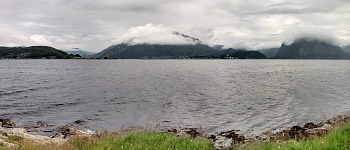 |
| It just stopped raining in Lauvvik. Clouds roll over hills in Lysefjord mouth. |
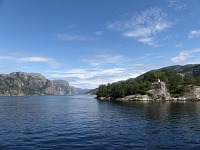 |
| A lighthouse next to Bergsholmen island in Lysefjord mouth. |
It rained in the morning and we were glad to have chosen a program that allowed
us to cowardly hide under a roof — in a ship's cabin. We were a bit
worried that we would not be able to see hilltops around the fjord, but that was
the program for the day. We were also considerably rejoicing over the fact that
we have found a laundry. The hotel had none, but in the adjacent mall, we
discovered the local version of a dry cleaning outlet. A lady behind the counter
claimed to not speak English, but she knew enough to explain that as far as we
would not mind the laundry not being dry-cleaned, ironed and folded, for
NOK 370 she would toss it in a washing machine and subsequently a dryer,
and we could pick it up in 24 hours.
Quality of our accommodation had suddenly risen in our eyes
— it was not cheap, but it was indeed a very convenient solution —
not having to spend several hours lingering around a machine and watching the
process; nor being forced to wash by hand in our bathroom and ponder with
difficulty how to dry it all. Under the influence of this good news, we extended
our stay by two more days — for those we got moved to a regular room
— but we didn't need our tub anymore, or larger bathroom and general
space. Then we reckoned that parking at the mall cost money, but our car was
under a roof, which eliminated the need to stumble somewhere with bags in
a rain. The mall included two grocery stores, giving us easy opportunity to
collect snacks for the day — without having to store them at our room.
We drove off to Lauvvik with light hearts, despite the rainy weather.
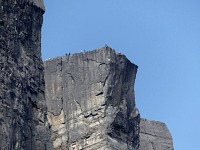 |
| Tourists milling on the edge of the Pulpit Rock. |
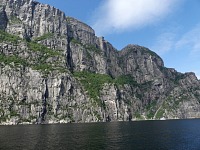 |
| Pulpit Rock is a precipice over a sheer cliff down to the fjord. |
A line of cars for the car ferry stood in the harbor, but we parked on the side
near a bench overlooking the fjord. We came very early, but after all we did not
want to risk missing the boat. Meanwhile it stopped raining and we began to
admire tall hills wrapped in clouds. And we watched as cars were being loaded on
two ferries that managed to come, one after the other. Sid remembered that in
1991, you drove onto the boat, it departed, and during the crossing a conductor
came by to collect money. Lately, cars have transponders and everything is
automated — but people are still needed to direct and stash cars so that
the boat loads as many as would fit — trucks, trailers and motorhomes load
separately from passenger cars. The whole loading lasts only a few minutes
— since cars get arranged in lines on the shore so that they just drive
in.
The passenger ferry moored eventually, and loading was even simpler —
the ferryman held a list of names, checking off people as they boarded. I was
glad, for we had no Norwegian phones and Norwegian systems, and had no recourse.
An English-speaking tourist boarded last, waving his phone and claiming that he
purchased a ticket, but it seemed that the payment did not go through, and what
should he do? Tourist and ferryman alike pecked at their gadgets, trying to
figure out what happened — and the boat stroke off and to the surprise of
ours and the tourists's — simply went with all of us away. The ferryman
eventually proposed that the chap buy another ticket, for another ferry or later
boat, for once he paid, he can ride. In this aspect, Norway reminded us of
Wyoming — an attitude that problems can be worked out, no need to panic
or despair.
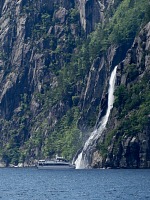 |
| A small cruise ship offers tourists an exclusive shower in Hengjanefossen falls |
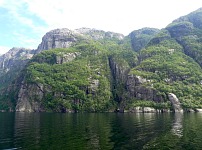 |
| Lysefjord is large — here with kayaks for scale. |
We took seats inside the boat, but in the end spent most of the time up on the
top deck. Sun crawled out and things got pretty. We were obviously not the only
people who scorned the offers of a cruise, and instead went for a regular
traffic boat — the top deck was crowded, while the boat was half-empty.
We slithered under a bridge and entered Lysefjord proper. From surface it looked
different again, emphasizing how high the rocky cliffs rise from sea level.
We passed Preikestolen with its crowds on the precipice (congratulating
ourselves for not being there), we viewed Hengjanefossen — that's the
highpoint for all those sight-seeing cruises and fast boats — we spotted
them too — a ship just under the falls, as well as boats crammed with
tourists strapped to seats with emergency vests on. Tourist bustle receded past
the waterfalls and we continued into the depth of the fjorden, stopping at
miniature jetties, where people disembarked and boarded, wearing trekking
backpacks. Flørli is worth mentioning — also offered as one of the
official attractions — four thousand four hundred forty four wooden steps
up to the mountaintop over the fjord. I admit that my knees ache when I only
imagine the stairs, but it was sure interesting to see.
We also saw Kjerag — the one we did not reach hiking, but we have pictures
now (again, with crowds). After approximately an hour we arrived to the fjord's
end, in Lysebotn. Most passengers disembarked here, a few boarded —
including a gentleman who came up saying he had a ticket for the morning ferry,
but missed it. Ferryman's answer was that having the ticket, he could ride
— no problem again. The way back was better, returning passengers we no
longer eager and tended to lounge in the cabin, which allowed us to take
pictures of the fjord without heads of tourists lining the railing — and
we snatched chairs on the aft, giving us a feeling of being millionaires on
their private yacht.
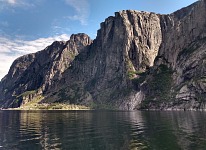 |
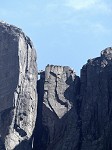 |
| Kjerag — a boulder jammed in a crevice on the edge of a cliff. |
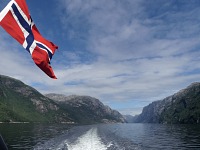 |
| Lysefjorden. |
I still owe you a detour to
søppel — the boat sported a sign
Ikke kast søppel over bord, with English translation (don't throw rubbish
overboard) and a pictogram. This clarified that the trailer in Mandal was no
advertisement for something, but a common trash box. Of course, since then we
use the word
sopel for rubbish.
Thus we came back to our hotel room relatively early — and decide to do
some shopping — Sid's shorts, which we brought along, had fallen apart,
and he demanded new ones. It brought out the advantage of our hotel being
located in downtown — checking out more or less ALL stores did not take
long. Eventually we succeeded in finding shorts for Hippo — moreover,
I found trousers fitting me. You can't call them shorts, for they are of length
appropriate for my age and figure — but they're made out of a lightweight
cheesecloth with camo pattern, hence they don't draw attention as much.
 |
| Kjelavika Beach — Carol wades in Norwegian Sea. |
It had been a good idea, for the following day turned hot, and that heat stayed
with us for the rest of our stay in Norway. Our frienda moved from Sinnes to
Fister, and we wanted to visit them there as well. Soňa had picked interesting
places for them to stay at, and the house in Fister featured North Sea and
included a small fishing boat. When we got there, the house was empty, but this
time we left nothing to chance and had obtained wifi password from our friends;
we also received a code to unlock the house. I made my coffee there and we ate
our lunch/snack in a civilized manner at a table — wondering where to turn
to, since we did not feel like fishing or dragging ourselves in this heat to
another waterfall. I remembered having noticed a turn-off to a nearby place
named Kjelavika, sporting a sign with a bathing person pictogram. Given the
temperatures, we decided to check it out. The bath offered a restroom, a mowed
lawn, benches, barbecue grills, and about ten more people. Hippo refused to
soak, but Yeti insisted on cooling off. I can straight admit that it took me
fifteen minutes to dip in — much longer than my actual stay immersed in
water, which was cold in a northern way.
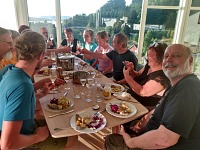 |
| Meeting with Czech friends: dinner is fish with mushrooms. |
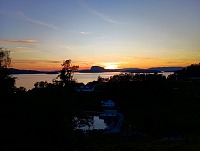 |
| In summer near Stavanger the sun sets shortly before eleven. |
Refreshed (at least I, dunno about Hippo), we drove back to the house. There, in
short order, both expeditions arrived, the fishing one with one fish, and the
waterfalling one with chanterelles. Exchange of the fishermen ensued, as well as
much boasting about who and if and how large fish they would yet catch.
I confess I got overcome by jet lag again, so I lazied on a deck chair. In the
meantime, people came and went, phone calls were made to check on fishing
progress, eventually turning into collective cooking — I let clam and
cockle soup pass, but the fish with potatoes and mushrooms was good. The sun
took its sweet time slowly setting over the sea, hence I insisted that we should
start returning to accomplish sleep for the rest of this super short, northern,
night.
For our Saturday, Soňa recommended a river flowing over bedrock, where people
bathe in granite pools. The way there goes through Sinnes and Sirdal tundra,
which drew our interest during our trip to Kjerag. We stopped in the tundra,
admiring it and taking pictures, but we eventually even found the river. Not to
make things easier, the ski resort and local name of the bathing place is
Brokke; the river is called Fisstøylsåni. There is a tiny parking lot next to
the "badeplass" — but on a Saturday in the hottest heat that
Norway had ever recorded, there was naturally no place to park. We were just
about to give it up, when we spotted a convenient ditch that would accommodate
our Volvo — thus we ended up recreating there, albeit a bit upstream
— the main hole was crowded, because you can jump from a rock into the
river there — after I dipped about twice waist-deep in it, I must only
conclude that Norwegians must be more part-Yeti than me. I could not think of
jumping into that ice-box. We did nevertheless modestly splash in the nearest
pools; I moved gradually downstream until I found a place with a natural slide
— in the stream, you could slide on your butt into a shallow pool. The
spoiled Yeti took this as sufficient cooling-off, and he rumbled that in our
civilized Wyoming, we operate hot springs for such bathing.
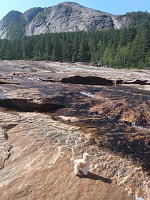 |
| Carol's mascot on Fisstøylsåni River near Brokke. |
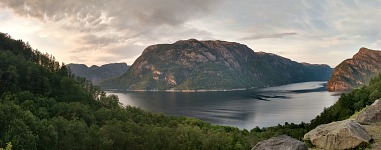 |
| Late evening in Dirdal: Frafjorden. |
On our way back we explored ways to hike the tundra somewhere. Despite how many
tourists visit Norway, marked trails are in short supply, so we just scrambled
up some hill. I forgot my Ventolin, but I think I would have been wheezy event
with it. There's just not that much chance to walk on even ground in Norway, and
if you don't walk directly on rock, you sink ankle deep into mud, squelching
around like a swamp monster. Little paths present a problem, as they intersect
with sheep routes and keep disappearing as people (and sheep) try to avoid the
deeper swamps. Sheep appeared to be everywhere in this tundra, and being used to
beg, for they bunched near tourists and their cars, waiting what may fall out of
them. There were even signs in places asking people to please not feed the
sheep, since it creates more problems than does good.
Sunday was to be our last day at Lysefjord, so we had planned to drive in its
vicinity and check out various spots. We began with a waterfall in Jørpeland.
We could not figure out how to drive near it, in the end parking in a ditch
somewhere; only on our way out we noticed a paid parking downstream. Well, we
walked the trail from top — the waterfall was interesting by having
a bypass constructed from a cascade of concrete boxes — our guess is that
it could be fish ladders. Then we proceeded to a viewpoint at Høllesli —
but then it stopped raining and Lysefjord could in its full beauty — with
a lighthouse on an island, by which we rode two days earlier on the ferry. We
pondered our maps a bit, where to go — and chose a small road along the
south-eastern fjordbank.
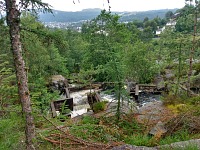 |
| Fish ladders on Jørpelandselva River. |
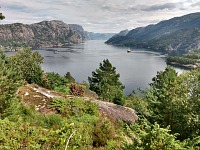 |
| Noon at Høllesli: view of Lysefjorden. |
The road went on and on, becoming narrower, but we aimed to drive to the very
end. We noticed a kayak rental place along the way and weighed whether it'd be
worth trying. Soňa said that one needs a license for an ocean kayak, and must
know to perform an Eskimo roll; that detracted us a bit. We had a snack at
a no-parking turn-off and watched relatively brisk traffic in switchbacks on
a hillside above us. This lured us to drive up and join them — a parking
lot with a restroom awaited us on top — and, according Sid's GPS, various
hiking trails. You probably think us stupid, but when we had researched places
to visit along Lysefjord, internet kept pointing us to Preikestolen, Kjerag and
Flørli, possibly the sightseeing cruises — but we discovered all less
famous attractions more or less by chance.
Meanwhile we opted to walk a bit on a road that was supposed to take us to
a small lake, telling ourselves that it was just the right thing for us —
on level ground, along a dirt road (closed for cars). The road led to the
obligatory creek with a waterfall, and past it stood a crossroads signpost.
Left trail went up to Sollifjell, straight went to a loop back to a lake.
A quite noisy French family was headed to Sollifjell, making us choose the
flat route and silence.
 |
| Sollitjørn pond in mezzanine to Sollifjell. |
The silence got severely disturbed by our cursing, when we began wading across
the moor turning into a swamp or brook and back to moor again. We found
ourselves in a gulch and had a choice to either turn back, or hike up to another
crossroads under Sollifjell. We hoped that the crossroads would offer some
views, but maintained our resolution to NOT HIKE UP ANY HILL. Thus we scrambled
up a wooded ravine for another half hour, which was so steep that we could pick
blueberries from the slope above us straight into our mouths. We met a young
couple with a baby, who asked us whether descending here in the woods was hard
— we assured them that except for the mud it was quite alright.
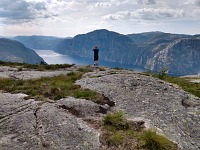 |
| Sid takes a picture from the top of Sollifjellet — 1,850 ft over Lysefjord. |
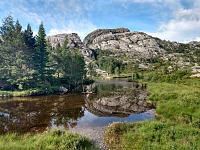 |
| Sollifjellet reflects in Fossåna Creek. |
Reaching the saddle crossroads, we found ourselves by a pond and
— for a change — treading mud. We did not let it distract us and
continued towards the fjord's edge — with the pond still in our way, but
even so, a view opened to Lysefjord — including Preikestolen overflowing
with people. We were congratulating ourselves how beautiful spot this was, still
picturing that we would NOT HIKE UP ANY HILL. But, over time, multiple tourists
came down the hill and every one of them was enthusiastic. So in the end we
climbed up Sollifjellet. The top was in the Norwegian way not much marked, with
paths diverging to avoid swamps, but then we stood on the edge from where one
could see most of Lysefjorden. And we were alone there — no pushing crowds
like on the Pulpit Rock. For our descent we chose the shorter way, which was
even less comfortable than the slope up — it was steeper, swampier and
rockier, and we slipped and jumped down and hoped to not to cripple ourselves
somewhere. Still we're bound to declare this attraction THE prettiest place
on Lysefjord — (relatively) accessible, crowdless and with awesome views.
Later at our hotel we studied whether Sollifjell is truly absent from the
list of recommended attractions — and we found it on some pages (now that
we knew the name to look for) — but always toward the lists' end and more
or less as a third-rated attraction — always behind those paid ones. Well.
We also needed to reserve accommodation for next days. Sid had been eyeing
some hotel near Bergen airport, but we had procrastinated and now it was sold
out. In a kind of pinch, we booked a room at Fjordslottet Hotell a little way
out of Bergen. Our route to Bergen was a question — whether to go on
ferries — or take six to eight hours detour through the mainland (thus
driving around fjords). Soňa had spooked us saying that sometimes cars without
prior reservation get to wait a long time for ferries — but we hoped that
she had meant boats headed to European mainland, or perhaps small ferries in the
less populated north, those that don't go frequently. Even our hotel
receptionist assured us that we should not worry, that she goes to Bergen to
visit family with no problems. I was rather curious to see how Norwegians manage
to load HIGHWAY traffic on ferries.























